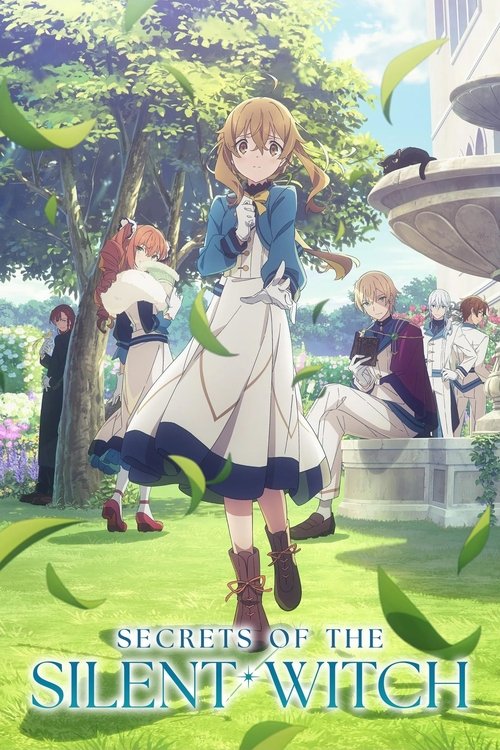
Ask Your Own Question
What is the plot?
Philia is introduced as the Saint of the kingdom Ziltonia, renowned for her perfection and saintly abilities, and engaged to the second prince, Julius. Despite her dedication and accomplishments, Julius unexpectedly breaks off their engagement, claiming that Philia's perfection makes her unlikable and lacking charm. Following this, Julius sells Philia to the neighboring kingdom of Parnacorta, which had recently lost its own saint and was struggling with monster infestations. Philia is sent away in exchange for gold and resources, forcing her to leave her homeland against her will.
Upon arriving in Parnacorta, Philia is surprised to find a warm welcome from the royal family and the people. She is assigned attendants who care deeply about her well-being, though they worry about her tendency to overwork herself. Philia immediately begins using her saintly powers to protect her new home by erecting magical barriers against monsters and curing epidemics that afflict the population. She gradually discovers that a saint does not need to solve every problem alone but should act when consulted, which helps her manage her workload and health better.
Meanwhile, back in Ziltonia, the absence of Philia causes the kingdom to deteriorate rapidly. The local officials and military, who had relied heavily on Philia's interventions, prove incapable of managing their duties properly. This neglect leads to the kingdom falling into chaos and decline, with doom looming as the infrastructure and social order weaken.
In Parnacorta, Philia develops a close relationship with the second prince Osvalt, who supports and encourages her. She begins to find personal motivation in her role as a saint beyond duty, exploring new hobbies and interests. Her feelings for Osvalt grow, and she starts to experience love for the first time, which contrasts with her previous life in Ziltonia.
As Philia settles into her new life, a new threat emerges: magic-users across Parnacorta begin to disappear mysteriously. A mysterious exorcist named Erza approaches Philia and reveals that demons are behind the kidnappings and that Philia herself is the real target of these dark forces. This revelation introduces a new dimension of danger beyond the monster attacks she had been combating.
Philia confronts this new threat by investigating the disappearances and learning about the demons' connection to ancient history. She and her allies work to uncover the truth behind the kidnappings and the demons' motives. This struggle tests Philia's abilities and resolve, pushing her to grow stronger and more independent.
Meanwhile, in Ziltonia, Julius continues his political scheming. He envies Philia's abilities and the respect she commands, as well as her healing of his father, the king. Julius works to isolate his older brother and let their father die, aiming to seize power through passive manipulation. He prefers Mia, another saint who admires and emulates Philia, over Philia herself. Julius courts Mia, using Philia's absence to his advantage.
Mia, upon learning that Philia was sold to Parnacorta, takes Philia's place as the saint of Ziltonia. She works to heal the king and restore the rightful crown prince to power, seeking revenge on Julius for his betrayal. Mia's actions create a political counterbalance to Julius's schemes and add complexity to the power dynamics in Ziltonia.
Throughout these events, Philia prioritizes the safety of her new home and the people she has come to care for, even placing her sisters' safety above her former kingdom. She faces challenges from both external threats like demons and internal struggles related to her identity and role as a saint.
The story progresses with Philia growing into her new life, overcoming threats, and building meaningful relationships, while Ziltonia faces decline and political turmoil due to Julius's ambitions and the absence of its former saint.
More TV Shows Like This
Browse All TV Shows →
What is the ending?
The ending of The Too-Perfect Saint: Tossed Aside by My Fiancé and Sold to Another Kingdom concludes with Philia Adenauer fully embracing her role as the Saint of Parnacorta, having grown beyond the burdens imposed by her past in Girtonia. Julius Ziltonia's betrayal is resolved with his kingdom's decline, while Philia's new alliances and personal growth secure a hopeful future for Parnacorta and those she cares about.
In the final episodes, the story unfolds with Philia Adenauer arriving in Parnacorta after being sold by her former fiancé, Julius Ziltonia. Initially overwhelmed by the betrayal and the weight of expectations, Philia gradually discovers that being a Saint does not mean solving every problem alone. She learns to delegate and trust others, which marks a significant shift from her previous overburdened state in Girtonia.
The first key scene shows Philia arriving at Parnacorta's capital, greeted with a mixture of hope and skepticism by the locals. She meets Oswald Parnacorta, the kingdom's leader, who expresses faith in her abilities. This meeting sets the tone for Philia's new beginning, emphasizing collaboration rather than solitary sacrifice.
Next, Philia confronts the reality of Girtonia's decline. News arrives that without her tireless efforts, the kingdom is falling into chaos. Officials and citizens alike are shown struggling to maintain order, highlighting how dependent Girtonia had become on Philia's perfectionism. This contrast underscores the story's message about the dangers of overreliance on a single individual.
Meanwhile, Julius Ziltonia's fate is sealed as his political maneuvers fail to stabilize Girtonia. His decision to discard Philia backfires, leading to his loss of influence and respect. Scenes depict his isolation and regret, but no redemption arc is given, marking a clear narrative judgment on his betrayal.
Philia's personal growth is vividly portrayed in a series of scenes where she explores new interests and forms genuine bonds with the people of Parnacorta, including her sisters Mia and others who support her. She begins to understand that a Saint's strength lies not only in power but in connection and trust. This is symbolized in a poignant moment where she chooses to protect Mia's safety over political concerns for Girtonia, showing her prioritization of personal loyalty.
The climax involves a confrontation with a looming monster threat, where Philia leads Parnacorta's forces with renewed confidence and teamwork. Her strategic delegation and reliance on allies result in a decisive victory, cementing her role as a true protector rather than a solitary savior.
The final scenes depict Philia standing with Oswald and her sisters, looking toward a future where she balances duty with personal happiness. Girtonia is shown in decline, a cautionary backdrop to Philia's new life. Julius is absent from this hopeful tableau, his story ending in downfall.
Thus, the ending resolves the main conflicts: Philia's emancipation from toxic expectations, the downfall of Julius and Girtonia, and the establishment of a new, healthier order in Parnacorta. Each main character's fate is clear--Philia thrives and grows, Julius falls, and Mia and Oswald remain steadfast allies. The story closes on a note of renewal and the importance of balance between duty and self-care.
Is there a post-credit scene?
Yes, the TV anime "The Too-Perfect Saint: Tossed Aside by My Fiancé and Sold to Another Kingdom" (2025) features a post-credits scene. In this scene, the main character is shown on a shooting spree at a pet store, which adds a surprising and somewhat humorous twist after the main story concludes.
What specific role does Julius play in the downfall of Philia and the kingdom of Ziltonia?
Julius, the second prince of Ziltonia and Philia's fiancé, envies Philia's abilities and respect within the kingdom. He resents her for healing his father and works to isolate his older brother to let their father die, aiming for a passive power grab. Julius sells Philia to the neighboring kingdom of Parnacorta, who had lost their own saint, in exchange for money and resources. This act removes Philia from Ziltonia, enabling Julius to court Mia, Philia's sister, and pursue his ambitions. His actions lead to the kingdom falling apart as Philia was the one managing many problems, and without her, monsters begin attacking everywhere, and the military struggles to contain them.
How does Philia's relationship with Osvalt, the second prince of Parnacorta, develop and affect her adaptation to the new kingdom?
Upon arriving in Parnacorta, Philia is immediately respected by the royal family and cared for by her attendants, who worry about her extreme work ethic. Osvalt, the second prince of Parnacorta, takes Philia on a tour of the kingdom and asks her personal questions, which confuses her as she never had time to develop personal interests. Osvalt works to ease Philia's transition into the kingdom and eventually comes to care for her. Philia, who had not experienced much personal care beyond her sister Mia, remains stoic and compassionate but begins to open up emotionally. Osvalt also authorizes extra military funds based on Philia's research about an approaching demon threat, showing his trust in her judgment.
What is the nature of the conflict involving the Demon Realm and how does Philia respond to this threat?
Philia's research leads her to believe that the Demon Realm is approaching the surface, a phenomenon that occurred 400 years ago when the demon Asmodeus invaded. She fears ridicule for suggesting this without evidence but is surprised when Osvalt authorizes extra military funding. Philia proposes casting a Great Purification Circle over Parnacorta, which would weaken monsters instead of merely keeping them out, allowing the military to kill them more effectively. This plan reflects her strategic approach to the looming supernatural threat.
How does Mia's perception of Philia and Julius evolve throughout the story?
Mia adores and emulates Philia, her older sister, and is devastated by Philia's absence after being sold off. She initially believes her father when told Philia left voluntarily but later discovers evidence that Julius conspired with her parents to sell Philia to another kingdom. Upon confirming Julius's guilt, Mia accepts his marriage proposal, not out of love but to manipulate and exact revenge by plunging him into despair. Mia also takes Philia's place as the saint of Ziltonia and works to heal the king and restore the rightful crown prince to power, showing her determination and strength.
What are the key differences in how Philia is treated and perceived in Ziltonia versus Parnacorta?
In Ziltonia, Philia is overworked and alienated despite being the greatest saint, despised by her parents and fiancé, and unappreciated by townspeople who favor her charming younger sister Mia. She is seen as too perfect and lacking charm. In contrast, in Parnacorta, Philia is warmly welcomed and respected by the royal family and attendants who care deeply about her well-being. She is fretted over for her extreme work ethic but valued for her abilities. This change allows Philia to experience genuine care and support, which she lacked in her home kingdom.
Is this family friendly?
The TV show "The Too-Perfect Saint: Tossed Aside by My Fiancé and Sold to Another Kingdom" (2025) is a fantasy romance anime with themes of abandonment, aristocracy, medieval settings, monsters, and political intrigue. It is not specifically categorized as family-friendly or children's content, as it deals with mature themes such as rejection, being sold to another kingdom, and complex interpersonal and political conflicts.
Potentially objectionable or upsetting aspects for children or sensitive viewers include:
- Emotional themes of rejection, abandonment, and familial coldness, including harsh treatment by parents and fiancé.
- Political intrigue and aristocratic power struggles that may involve manipulation and betrayal.
- Presence of monsters and epidemics, which may include scenes of danger or illness.
- Some characters exhibit mean or cruel behavior, which might be distressing for sensitive viewers.
There is no indication of explicit violence, sexual content, or strong language in the available information, but the emotional and thematic content may be intense for younger children or very sensitive audiences. The show is primarily targeted at a shoujo (young female) demographic, which often includes romantic drama and fantasy elements but can still contain mature emotional content.
In summary, this anime is likely more suitable for teens and older viewers rather than young children, due to its mature themes and emotional complexity.










































